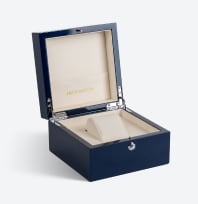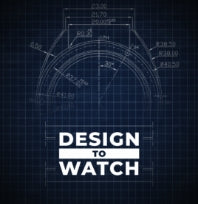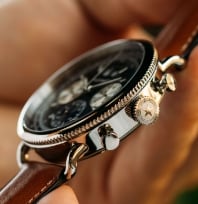Not All Watches Work The Same
The mechanism that keeps your watch ticking and telling the time accurately is called its movement. The three types of watch movements are mechanical, automatic and quartz. Each of these movements uses a unique mechanism to keep your watch running smoothly.
A watch’s movement is one of the primary factors that can distinguish it from other similar timepieces. The movement of a watch not only makes it function in a certain way, it can also determine how user-friendly the watch is for the wearer. In addition, certain watch movements can make a watch lighter or heavier than others.
When it comes to watch movements, there is no objective best option that is preferred by all wearers. Instead, your choice of watch movement comes down to personal preferences, budget, and the amount of time you plan on investing in caring for and maintaining your watch.
One of the most popular watch movements, automatic movement, has been used to power timepieces for centuries. Automatic movement has stood the test of time and remains a staple in luxury watches to this day. When you are on the lookout for an ideal watch, you’ll want to make sure to consider automatic movement.
This post goes in-depth about the inner workings of an automatic watch, as well as the history of the movement. Automatic watches may be centuries old, but the movement has stayed popular among watchmakers and enthusiasts alike – and with good reason.
If you’re curious about what goes on under the surface of your timepiece, keep on reading. We’re about to shed some light on how automatic watches work, their history, and why you should consider making automatic your movement of choice.
A Brief History Of One Of The Most Popular Watch Movements
Automatic watch movement was pioneered as early as the 1770s. The first automatic watchmakers created an innovative mechanism that was designed to transfer energy generated by a watch wearer's hand movements to a weighted rotor inside the watch.
When automatic watches were first invented, they were handheld pocket watches. These early automatic watches were not as accurate as the wrist-worn ones to come, and over a century would pass before automatic wristwatches became available to the public.
During the early 20th century, automatic watch movement was further innovated, and became even more cemented in watch-wearing culture. In the 1920s, watchmakers began making and selling wrist-worn automatic watches. These watches could transfer much greater amounts of energy from the wearer to the mainspring. This increase in energy transfer and storage gave automatic wristwatches the ability to stay ticking for much longer than their handheld predecessors.
At this point, automatic watch movement was beginning to compete with mechanical movement, which required wearers to manually wind their watches. Automatic watches offered convenience and accessibility that made them attractive to consumers, and automatic movement was just as reliable as mechanical movement when used by an expert watchmaker.
Automatic Watches: The Pros
An automatic watch’s weighted rotor spins as the wearer turns his wrist, allowing for energy to be stored in the watch’s mainspring. The energy stored in the mainspring can then keep the watch ticking accurately without manual winding for long periods of time. This mechanism makes automatic watches extremely convenient for the wearer.
The weighted rotor mechanism inside an automatic watch gives it a distinct heaviness. For many watch enthusiasts, the weight of an automatic watch has a unique appeal. High-quality automatic watches typically weigh more due to the use of a heavier weight, and one of the best ways to discern an automatic watch’s quality is by how it feels in your hand. A heavy watch is not necessarily a better watch, but the heft of an automatic watch tends to be a promising sign.
Automatic watches also have a unique appeal for purists who prefer to keep things as classic as possible. Since quartz watches have become more and more prevalent in the last few decades, sticking with an automatic watch can be an act of devotion to a longer-running form of watch movement. For watch purists, wearing a mechanical or automatic watch is an opportunity to take a unique level of pride in one’s timepiece.
Automatic Watches: The Cons
The only thing that stands in the way of an automatic watch continuing to work without manual winding is if it is not worn. For an automatic watch to keep ticking, it needs to be worn consistently. The transfer of energy from your wrist to the watch’s mainspring by way of the weighted rotor is what keeps your automatic watch ticking. So, if you leave your watch off for long periods of time, it may need to be wound manually.
The need for manual winding from time to time makes automatic watches inherently higher-maintenance than quartz-powered watches. Opting for an automatic watch means making a commitment to taking some time to maintain your watch to keep it running smoothly. In contrast, a quartz watch, powered by a battery, will run and keep time accurately until its battery needs to be replaced.
Choosing to wear an automatic watch can also be less appealing for some based on the weight of the automatic mechanism. In the same way that the heaviness of automatic watches make them desirable for many watch wearers, this weight can also make an automatic watch feel cumbersome for some. If you prefer a watch that feels as light as possible, a quartz watch is likely a better pick for you.
What Kind Of Automatic Watch Should I Get?
Once you decide that automatic movement is right for you, you still have plenty of freedom to choose what your watch will be like. A watch’s movement is completely independent from its outward design– that means you can have an automatic dive watch, pilot’s watch, and more with automatic movement.
Knowing that your watch’s movement is independent from its type, it is always worth it to explore the different types of watches once you decide what movement is right for you. Depending on your lifestyle, fashion preferences, job, and other factors, you can find an ideal watch design that meets all your needs.
Your watch is one of the most important elements of any outfit you wear. A watch can make or break your look, so knowing how to pair your timepiece with different outfits and occasions is a precious skill. Whether you are someone who tends to dress formal or more casual, a watch can complement your style and take an outfit to the next level. It’s all about knowing how to choose the right one for you.
The Automatic Dive Watch: A Timeless And Versatile Timepiece
If you are looking for an ideal everyday watch that is right at home paired with a suit and tie or a t-shirt and jeans, an automatic dive watch might be exactly what you are after. With a classic look that has been sported by generations of sharp-dressed men, the dive watch is both simple and elegant.
Dive watches were originally designed to withstand the high pressure of the ocean’s depths. However, their good looks made these timepieces attractive to more than just deep-sea divers. Dive watches quickly became staples in men’s fashion in the mid-20th century, and they haven’t gone anywhere ever since. With an automatic dive watch, you can count on the perfect combination of form and function. Dive watches traditionally have minimal complications, and can be worn well with either a leather or metal band.
Automatic Aviation Watches: Useful, Great-Looking, And Steeped In History
When international flights and passing between time zones became the new normal for aviators in the 20th century, pilots needed a watch that could meet their specific needs. During this aviation renaissance, the modern pilot’s watch was born. Featuring a wide array of unique complications, a pilot’s watch is excellent for professional pilots and hobbyists alike, as well as for the fashion-conscious gentleman who appreciates a well-crafted timepiece.
Aviation watches are uniquely elaborate in their design, often featuring a date complication and a multi-scale chronograph, a pilot’s watch can complement a formal or casual outfit.
Quartz Vs. Automatic: Is There A Winner?
When it comes to watch movements, there is no objective best option that we unanimously recommend. The modern era of watchmaking has seen quartz movement rise up to compete with automatic movement. Quartz is a worthy contender as a watch-powering mechanism, powered by a battery instead of a rotor. Quartz watches are famously low-maintenance, and often feel lighter to wear than their automatic or mechanical counterparts.
Ultimately, there are pros and cons of each type of watch movement. For most men, the decision is typically between automatic and quartz, and both are excellent choices. Automatic watches have a longer-running history than quartz-powered timepieces, and they often appeal to fans of the classics. However, quartz watches offer a unique level of accessibility and take the cake in terms of user friendliness. The choice between the two is, in the end, up to each man to make for himself.
Sources:
https://www.gearpatrol.com/watches/a93012/how-does-an-automatic-watch-movement-work/
https://www.bloomberg.com/news/articles/2019-09-24/how-world-war-i-changed-watches-forever
https://www.realmenrealstyle.com/quartz-mechanical-automatic-movements/












